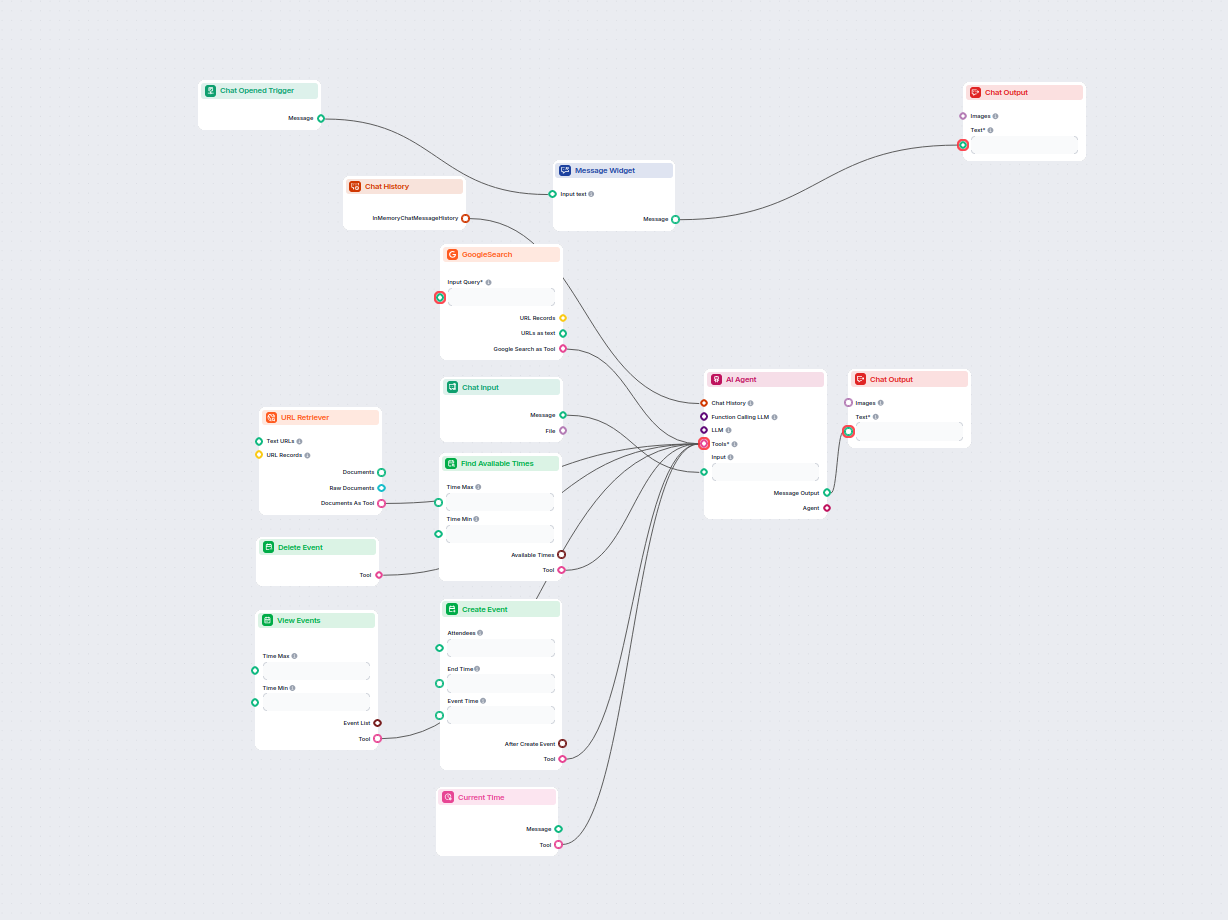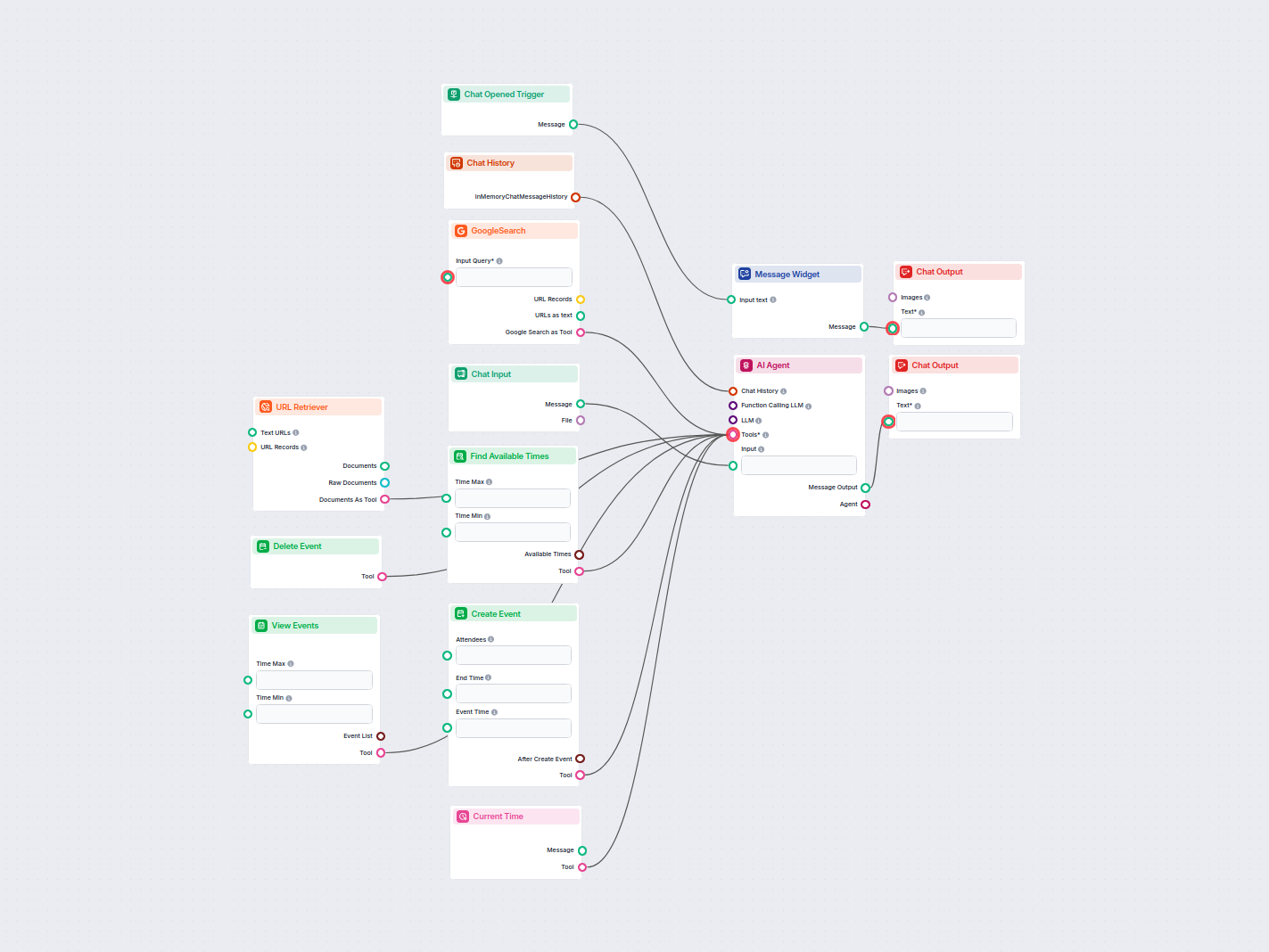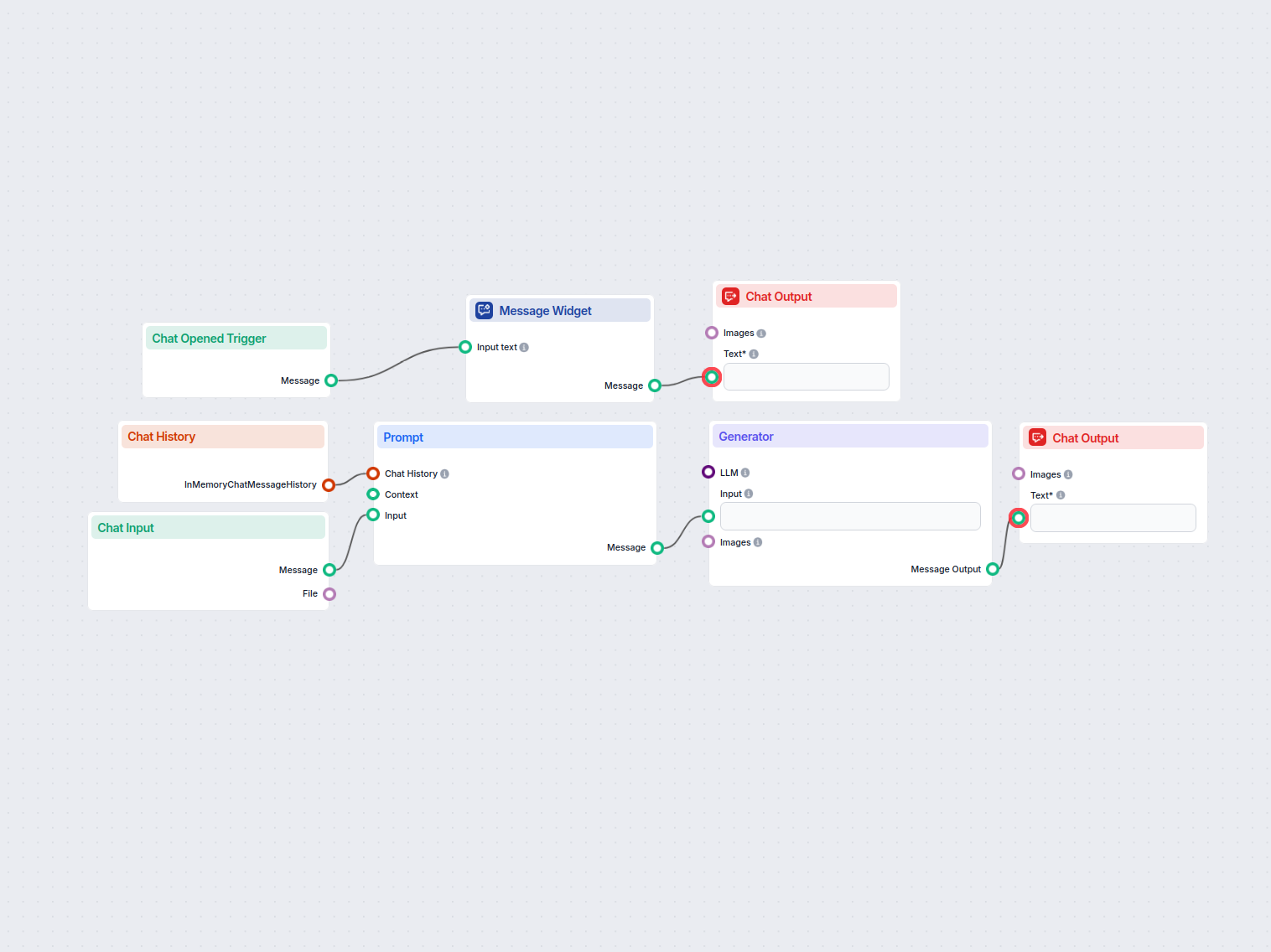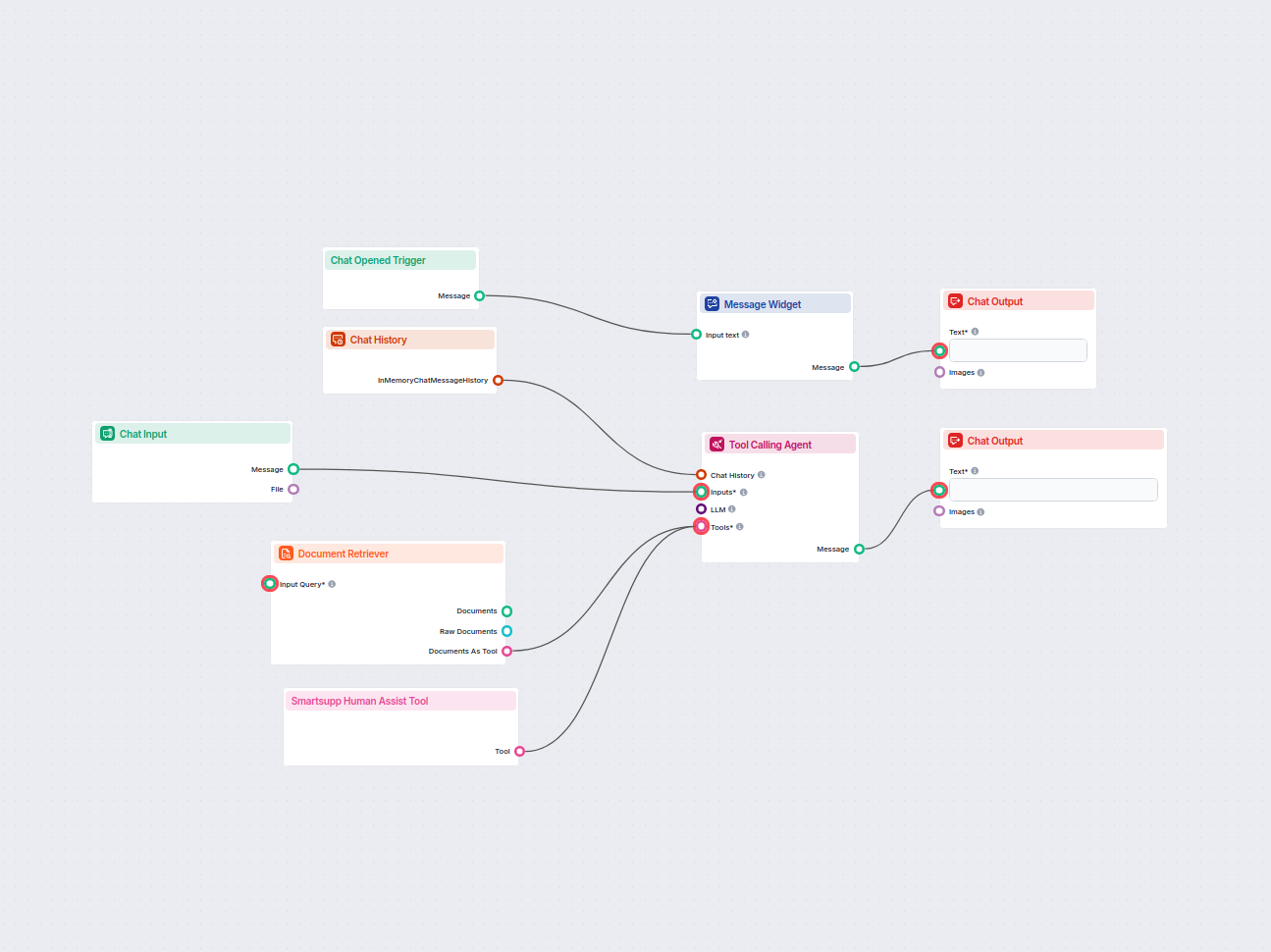AI Agent
AI Agent that can connect to tools and generate responses.
This AI-powered workflow automates meeting scheduling through Google Calendar. Users interact with a chatbot that finds available times, creates, views, or deletes events, and even leverages Google Search and URL content extraction to assist with scheduling. Ideal for boosting productivity and streamlining calendar management for teams and professionals.

Flows
AI Agent that can connect to tools and generate responses.
Below is a complete list of all components used in this flow to achieve its functionality. Components are the building blocks of every AI Flow. They allow you to create complex interactions and automate tasks by connecting various functionalities. Each component serves a specific purpose, such as handling user input, processing data, or integrating with external services.
The Chat Opened Trigger component detects when a chat session starts, enabling workflows to respond instantly as soon as a user opens the chat. It initiates flows with the initial chat message, making it essential for building responsive, interactive chatbots.
The Message Widget component displays custom messages within your workflow. Ideal for welcoming users, providing instructions, or showing any important information, it supports Markdown formatting and can be set to appear only once per session.
Discover the Chat Output component in FlowHunt—finalize chatbot responses with flexible, multi-part outputs. Essential for seamless flow completion and creating advanced, interactive AI chatbots.
The Chat History component in FlowHunt enables chatbots to remember previous messages, ensuring coherent conversations and improved customer experience while optimizing memory and token usage.
FlowHunt's GoogleSearch component enhances chatbot accuracy using Retrieval-Augmented Generation (RAG) to access up-to-date knowledge from Google. Control results with options like language, country, and query prefixes for precise and relevant outputs.
The AI Agent component in FlowHunt empowers your workflows with autonomous decision-making and tool-using capabilities. It leverages large language models and connects to various tools to solve tasks, follow goals, and provide intelligent responses. Ideal for building advanced automations and interactive AI solutions.
The Chat Input component in FlowHunt initiates user interactions by capturing messages from the Playground. It serves as the starting point for flows, enabling the workflow to process both text and file-based inputs.
Unlock web content in your workflows with the URL Retriever component. Effortlessly extract and process the text and metadata from any list of URLs—including web articles, documents, and more. Supports advanced options like OCR for images, selective metadata extraction, and customizable caching, making it ideal for building knowledge-rich AI flows and automations.
Easily identify optimal time slots for scheduling events by analyzing calendar availability. The Find Available Times component checks free and busy blocks across user and attendee calendars, returning the best available times in chronological order. Ideal for automating scheduling tasks and streamlining meeting coordination.
Easily automate the removal of events from Google Calendar with the Delete Event component. It connects directly to your calendar, enabling workflows to delete events and optionally notify attendees, streamlining calendar management within your flows.
The Create Event component in FlowHunt lets you automate the creation of events in Google Calendar. Easily specify attendees, event time, description, and more, with options to generate Google Meet links and set reminders—streamlining scheduling in your automated workflows.
The View Events component lets you fetch and filter calendar events within a chosen time range, leveraging Google Calendar integration. Ideal for automating workflows that need up-to-date scheduling data, it supports searching events, limiting results, and customizing attendee parameters.
The Current Date Tool component in FlowHunt enables workflows to access the current date and time, adjustable to a wide range of timezones. Essential for automating tasks and generating time-aware responses, this component makes it easy to integrate up-to-date temporal information into your flows.
Flow description
This workflow transforms an AI chatbot into a smart, automated meeting scheduler that integrates directly with Google Calendar. It enables users to converse naturally with the chatbot to schedule, update, or delete calendar events, making the process seamless and scalable for both individuals and organizations.
When a user opens the chat, they’re greeted with a friendly welcome message, explaining the chatbot’s capabilities in helping schedule meetings with just a few details (such as who, when, and where). This interaction is handled by the following sequence:
| Step | Component | Purpose |
|---|---|---|
| 1 | Chat Opened Trigger | Detects when a chat session starts. |
| 2 | Message Widget | Displays a welcome message to the user. |
| 3 | Chat Output | Shows the welcome message in the chat window. |
When a user submits a message (e.g., “Schedule a meeting with John next Tuesday at 3 PM”), the workflow captures this input and processes it through the following logic:
The AI Agent is enhanced with several specialized tools to fulfill meeting-related tasks:
All these tools are connected to the AI Agent, which decides which to use based on the user’s request.
Once the AI agent completes a task (like scheduling or canceling a meeting), it generates a response that is displayed back to the user through another Chat Output component, confirming the action or providing further instructions.
| Component Name | Role in Workflow |
|---|---|
| Chat Opened Trigger | Initiates welcome sequence |
| Message Widget | Displays welcome/info messages |
| Chat Input/Output | Handles user interaction and responses |
| Chat History | Maintains conversational context |
| AI Agent | Central intelligence and decision-making |
| Google Calendar Tools | Manage events (create, view, delete, etc) |
| Google Search/URL | Supplementary data retrieval |
| Current Time Tool | Provides time context |
This workflow is ideal for automating and scaling the often-tedious process of meeting scheduling. By leveraging AI and direct Google Calendar integration, it empowers users to manage their calendars efficiently, save time, and reduce the risk of errors or double-bookings—all through an intuitive chat interface.
We help companies like yours to develop smart chatbots, MCP Servers, AI tools or other types of AI automation to replace human in repetitive tasks in your organization.
An intelligent AI assistant that integrates with Google Calendar to help users manage their schedules. Users can interact via chat to check their events, find a...
A simple AI chat assistant workflow that leverages previous conversation history to generate relevant responses to user input. Includes a welcome message and us...
This workflow creates an AI-powered chatbot integrated with Smartsupp, leveraging an internal knowledge base to answer customer support inquiries. If the chatbo...
Cookie Consent
We use cookies to enhance your browsing experience and analyze our traffic. See our privacy policy.



